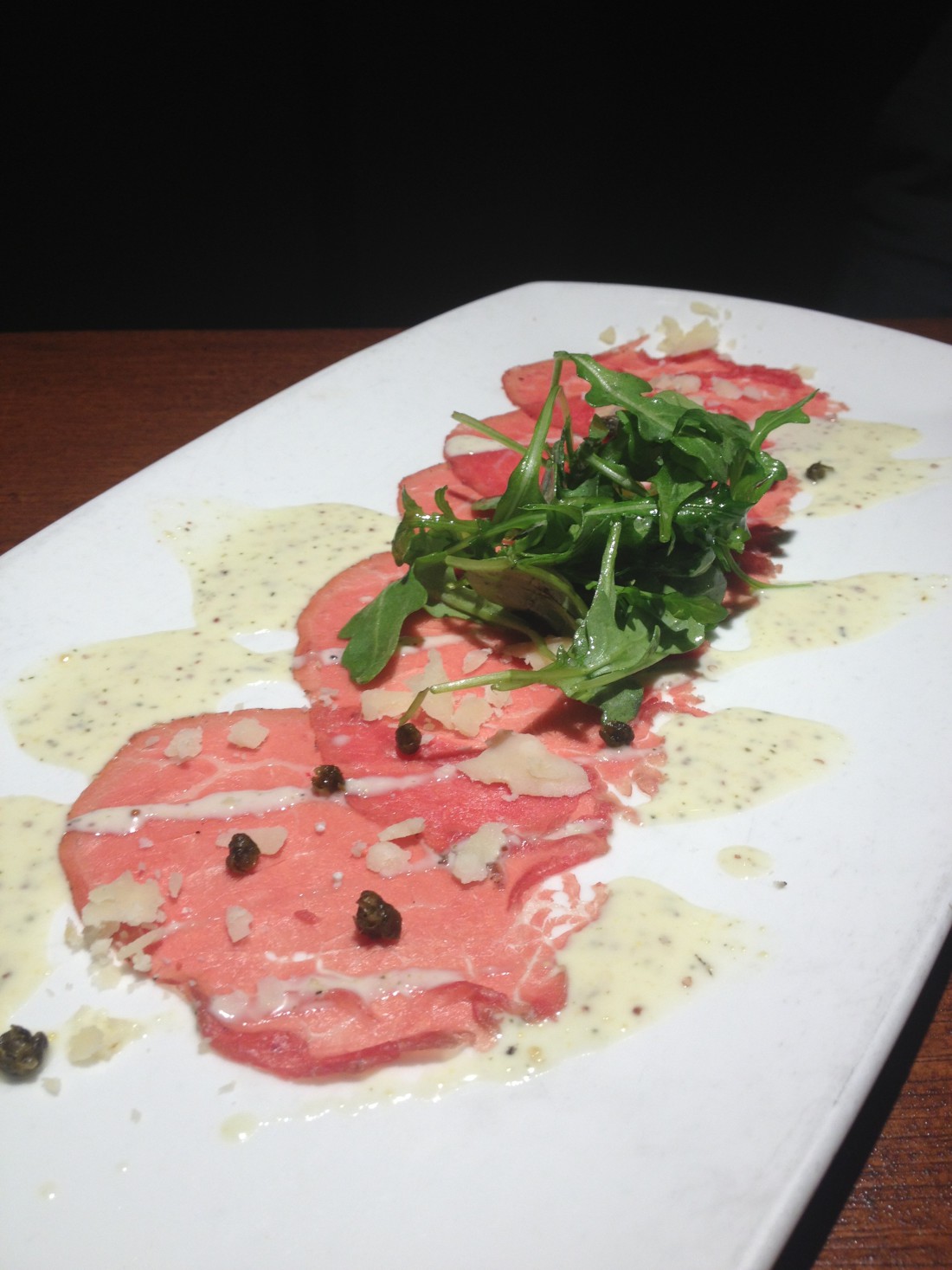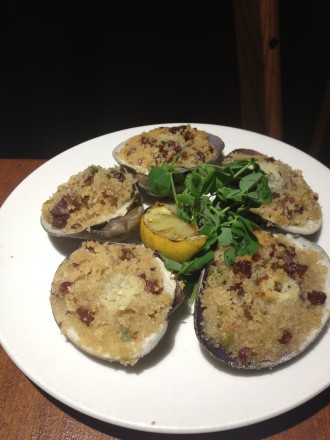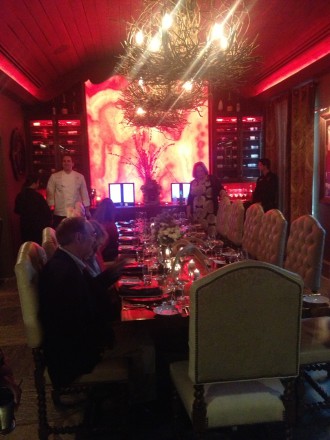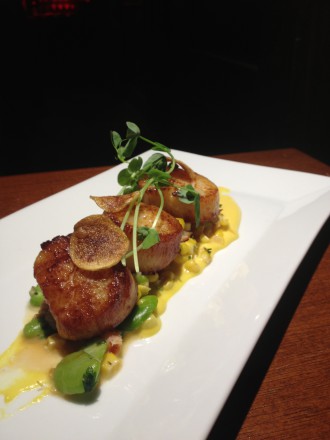From the sidewalk, the Grand Bohemian looms above, with the classic tiled, peaked roofs that have become the staple feature of Biltmore Village over the decades. Through the front doors, ornate gold-leaf pillars and wood and leather wall panelings complement the antler chandeliers and stone fireplace.
“It’s that classic hunting lodge look, complete with a real wild boar,” explains the hotel’s general manager, John Luckett, as he guides our group from the gallery through the lobby to the dining room during a recent media dinner event. As we pass, he pats the furry head of a taxidermy tusked pig sporting a festive bowler cap.
The event is to offer a taste of the new menu items from the hotel’s executive chef, Scott Ostrander. “This is about giving everybody an idea of what the Red Stag Grill is going to be about from the spring on into the summer,” he explains.
Before we are seated, we are given the bar’s seasonal signature cocktail, the Carolina Cup, a mix of Troy and Sons Blonde whiskey and Asheville Bee Charmer honey topped with a sweet house-made mint foam. Servers emerge with local eggs, deviled and topped with house-smoked tasso ham and pickled shrimp. Wild North Carolina cherrystone clams are served with bacon and spring onions. And then there are spoonfulls of pulled Hickory Nut Gap pork shoulder barbecue with spices and sorghum.
We are seated in a private dining room adjoining the kitchen. A sprawling wooden table is flanked with a dozen high backed chairs and those ubiquitous antler chandeliers dangle over head. The lights are dim, and the room carries a red glow from the giant lit wall that separates the two end-caps of a well stocked wine locker.
First comes the wine, a crisp, clear Gruner Veltliner from Abbazia di Novacella. The first course quickly follows: bowls of bright-green. chilled watercress bisque, dotted with blue crab, cucumber and horseradish. Just as we are slurping down the list drops of the chilled soup, the waiters make their rounds with the second course, a paper-thin sliced Wagyu beef carpaccio with Lusty Monk mustard and New River microgreens with tiny capers scattered across the plate.
“I come from a background of very high-end, but small restaurants, so this is my first real foray into the hotel restaurant world,” says Ostrander. “I think the Grand Bohemian is a great place for me start that, because I have a beautiful space to showcase in.”
“It seems like it would be hard to be over the top or too decadent in a place like this,” I comment, noting the plethora of antlers hung on the wall, gold-leaf panels flanking the perimeters.
Ostrander smiles. “It’s a nice little sandbox to play in, that’s for sure.”
And then comes the third course: sea scallops with lobster, corn and fava beans with golden beet butter. There’s a kind of sweet, savory, umami thing going on here that is both distinctly Southern and tantalizingly foreign.
Somehow — probably the fault of those sneaky, ninja-like servers — our glasses are filled with the next round of wine. This time, bulbous stems are filled with Albert Bichot’s Bourgogne, a rusty red pinot noir. Then comes round four: thinly sliced Sunburst trout with a sweet carrot puree, sugar snap peas and maitake mushrooms.
Originally from the upper Hudson Valley just South of Albany, N.Y., Ostrander has come by his penchant for local goods honestly. “My grandfather had about a 30-acre produce farm, so I grew up as a farm kid with access to beautiful fresh produce all the time,” he says. “We used to trade produce for eggs and chickens and bread, so I grew up with a good appreciation of the land and products and what it takes to be a grower, which is, I think, what kind of drew me to this whole farm-to-table movement.”
“We have access to so many cool local [producers] around here, I just want to use everything. We use as much as we can, and it will be more once it gets into season. It’s a little difficult with produce right now, because the season is just starting, but we still try to get a lot of local meats and local cheeses, microgreens and whatever we can get year round.”
“I’ve been some places where the clientele is happy to eat beets and collards all the time, but here at the Red Stag, we have a little bit of a different clientele with a bit different expectations,” Ostrander explains. “In the winter, we are working a lot with the pork, the beef, the Sunburst trout. So in the winter, we’re probably only about 15 percent local. But in the summertime, we’ll be upward of 40 percent local. Forty percent is a good number when you factor in that, obviously, your oils and your butters are a little harder to source locally. So I would say that if we are in the 30 percent range of our food being local, then that’s pretty strong.”
Next comes the Hickory Nut Gap rabbit loin with rabbit confit, white asparagus and pickled rhubarb — easily my favorite course of the night. There’s a rich savory bedding that plays nicely with the tangy, sour pickled rhubarb and asparagus.
Then comes more wine. This time it’s the house’s own label, a cabernet blend made by Raymond Wines in California.
The sixth course leisurely follows. By now, we are all starting to slow down. Apple Brandy beef ribeye steaks sit on Vidalia onions and heirloom tomatoes, topped with an herb chimichurri.
“We used to only use Brasstown beef, but I wanted to get some more local things on the menu, so I reached out to Apple Brandy and got back on board with them, and decided to feature them on our a la carte menu,” explains the chef.
After graduating from the Culinary Institute of America, Ostrander traveled across the country to the West Coast work under the tutelage of celebrity chef Roy Yamaguchi. “You don’t get a chance to see those ingredients and those kinds of fish on the East Coast,” he explains.
“You can still play with those flavors a good bit, just throwing pieces of them in,” he says, explaining the constant play of savory and umami flavors in his dishes. “Working at the hotel, I’ve had the opportunity to incorporate them some. We had a group a few weeks ago of 10 attendees who were coming from Japan, so I had that in my lexicon to be able to make traditional Asian food for them for breakfast. So it helps out in ways that you’d never expect when you’re going through it.”
After the entree comes the cheese. A thick slice of Looking Glass Creamery’s Ellington goat cheese sits next to a pool of strawberry-rhubarb preserves.
As our pants are beginning to feel uncomfortably tight, we try to bear in mind that we are in the home stretch. Just three more decadent servings to go. And a five-year aged Madeira from Blandy’s should make the last leg a little easier.
As we sip the wine, the onslaught of desserts is served. Pecan carrot cake — moist, chewy and perfect. An incredibly dense salted caramel chocolate torte, a flourless flavor bomb that is sure to stick with you. And then the blueberry mascarpone cheesecake; rich, flavorful and creamy.
“I just like to buy really good ingredients and not screw them up. … I mess with them as little as possible,” says Ostrander. “You can’t really lose doing that.”
After tasting nearly a dozen servings from his kitchen, I’m definitely inclined to believe him.






Before you comment
The comments section is here to provide a platform for civil dialogue on the issues we face together as a local community. Xpress is committed to offering this platform for all voices, but when the tone of the discussion gets nasty or strays off topic, we believe many people choose not to participate. Xpress editors are determined to moderate comments to ensure a constructive interchange is maintained. All comments judged not to be in keeping with the spirit of civil discourse will be removed and repeat violators will be banned. See here for our terms of service. Thank you for being part of this effort to promote respectful discussion.